Derain white: characteristics and features of care
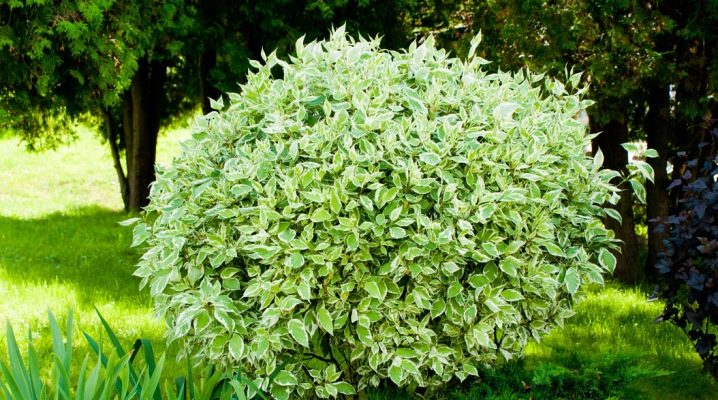
Landscape designers have long noticed an unpretentious plant of the White Dogwood family. It is planted not only in personal plots. In cities, courtyards are ennobled with it, because with its help it is very easy to carry out zoning of the site. It easily tolerates heat and cold, is not afraid of pests and diseases - the dream of any gardener. Considering that in the Russian language the letters "e" and "ё" are colloquially equated, the name of a fast-growing shrub is written as a dogwood or dogwood. A beautiful and varied horticultural crop used in landscaping is familiar to many under the name dogwood. Out of fifty of all species, about a dozen are white turf.
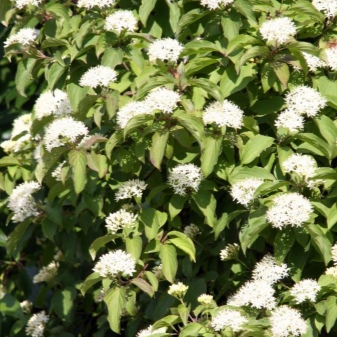
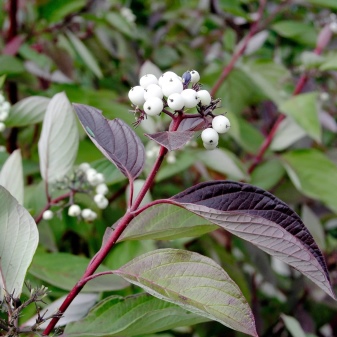
Characteristic
CornusAlba is a common plant. It has several synonymous names: Tatar deren, dogwood, telikrania, svidina, svida. Different species have the life form of a tree or shrub. There are also several types of herbaceous perennials. In the form of a tree, the plant reaches 5 meters in height, in the form of a shrub - from 25 cm to 3 m. The diameter of the crown in different species is from 1.5 to 5 meters.
Habitat: many varieties of deren grow from Chukotka to Japan, on the Atlantic coast, the Far East, and the north of the European part of Eurasia. White svidina prefers to settle in northern Asia. Runs wild quite often. The brightly colored seeds are often eaten by birds and are carried around the world.
White dogwood got its name not only because of the color of the fruit, but also because of the color of the leaves. Moreover, these can be different types of plants.
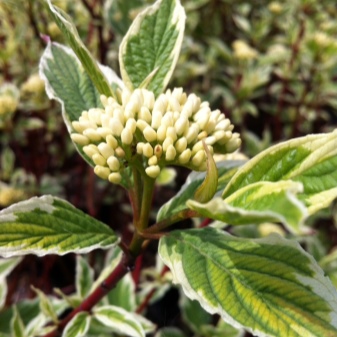
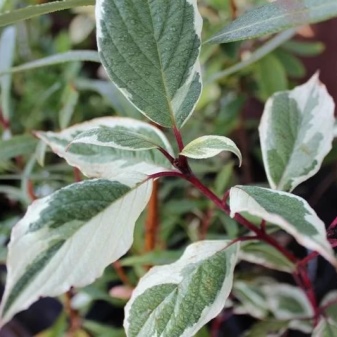
Cultivated forms can have white, yellow, red, gray fruits. The crown of plants is from white - silver to variegated, golden color. Flexible shiny branches can be bright red, yellow, red-brown. Milky-white inflorescences have a diameter of 5 cm. It blooms in May-June.
The fruit is a drupe from 1.5 to 3 cm. In an immature form it has a bluish color, when ripe it changes to white-blue.
If an ordinary dogwood is an edible berry, white is not poisonous, but you cannot call it tasty, although the birds like it. Fruit ripening time: August-October.
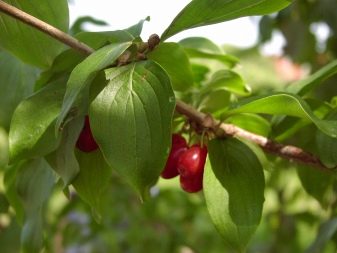
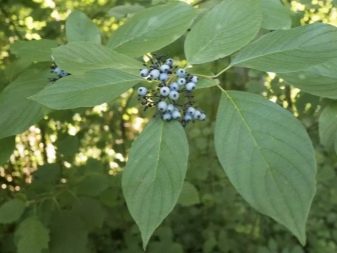
Svidina is good at any time of the year. In winter, when the shrub is leafless, the bright branches, beautifully trimmed into a ball or square, will be visible far away. In the spring, bright foliage appears, and in May, white inflorescences cover the entire bush with a hat. Over the summer, the leaves gain brightness, and the flowers turn into berries, also gradually changing color. Autumn pleases with bright colors, showered with autumn leaves from the turf. And such beauty can be observed not only in their own gardens, but also on the river banks or along the roads.
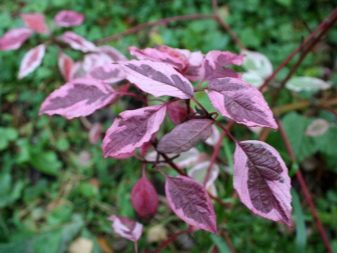
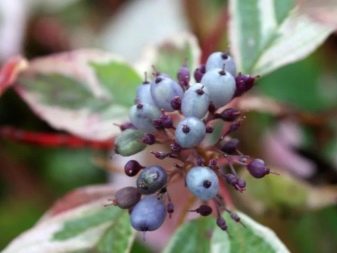
Varieties
The varieties of turf are the result of the selection of specialists from all over the world from North America to Japan through Europe and Asia. As a result, the following decorative types of svidina appeared.
"Argenteomarginata" ("Elegantissima")
A well-known bush variety, which is a hemisphere that goes up to 3 meters. A long-lived plant with a lifespan of 50 years has branchy branches and a white-bordered leaf. The bright red twigs are not visible in summer due to the foliage and the large number of white inflorescences.But in winter they can be seen from afar. In the fall, telikrania turns into a bright yellow, orange or purple ball.
Elegantissima begins to bloom in the last month of spring and pleases with its flowering until the end of June. Small white flowers are formed into corymbose inflorescences. Elliptical green leaf plates are bordered by a white zigzag stripe. Because of this color, it seems that the foliage is openwork. Even growing constantly in the shade, the shrub does not lose its two-tone color. In August, blue-white berries begin to ripen. The shrub grows up to 40 cm per year. Not afraid of frost, drought, shade.
Since it grows very densely not only upwards, but also to the sides, it is often used as living fences.
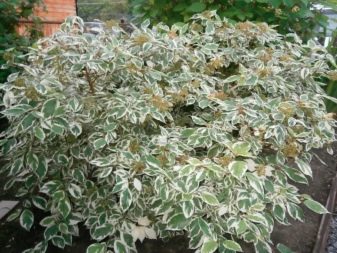
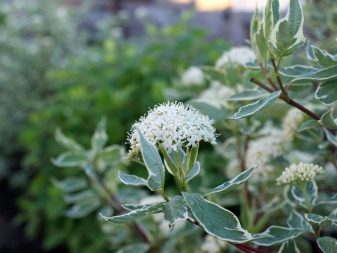
Ivory Halo
Unlike other varieties of white turf. It's about growth - the height of the plant is about 1.5 meters. This is good for landscaping the park area along the paths, for gardens, since the bush will not cast much shade. The plant is used as an element of a group planting and as a lonely standing specimen. Svida's shoots are cherry-colored, and the leaf plates are green with a wide yellow border. White spherical fruits at the time of ripening acquire a gray-blue hue. And the leaves turn crimson by autumn.
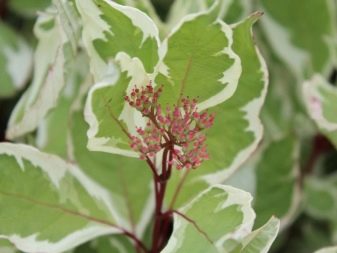
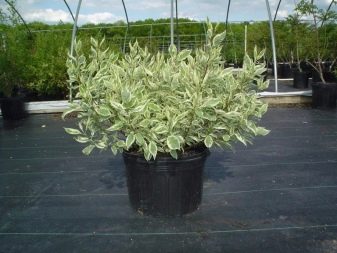
"Aurea" (Aurea)
Fast-growing deciduous shrub up to 2.5 m in height and up to 3.5 m crown diameter. The vertical thin branches are red-brown in color. Matte leaf plates are not habitually elongated, but wide-oval. The color of the foliage changes during the growing season from brownish-burgundy through golden yellow to reddish or lemon. Creamy white honey-scented inflorescences bloom in June, sometimes a second time in September. Inedible blue-white berries appear in early autumn. When placed in the shade, foliage cannot acquire a golden hue. Drought-resistant, does not require winter shelter.
Like other varieties, Telikrania is disease resistant. Perfect for landscaping.
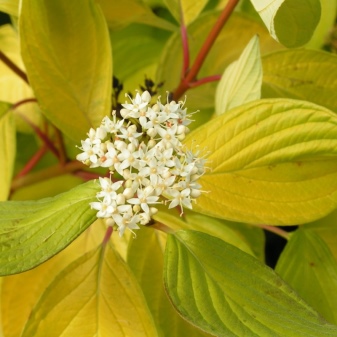
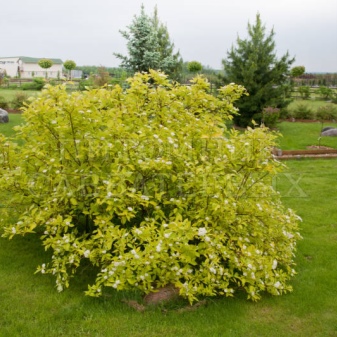
Gouchaultii
Decorative deciduous dogwood with a cap of 3 m in diameter. Bright red branches, variegated deciduous plates: greenery bordered with yellow-pink, many white-blue fruits that appear after the flowering of white inflorescences. In autumn, the deciduous plates take on a color ranging from pale pink to purplish red. The length of an elongated leaf is about 8 cm. It grows better in sunny glades, but it also tolerates shady places.
It can do without watering for a long time, but the soil should not be hard. Due to the flexibility of the branches, it is highly wind-resistant. If the shrub is planted for the purpose of ennobling the garden area, constant pruning is required to give it tidiness, however, like other ornamental varieties. If the planting was carried out for the purpose of landscaping, then the plant completely dispenses with pruning, it is frost-resistant.
In Russian transcription, Gouchaultii has several names: Guhalti, Gouchaulti, Gouchaulti, Gouchaulti.
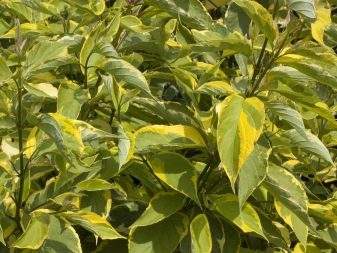
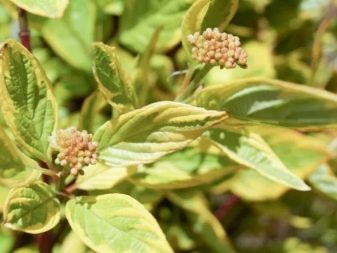
Cream Cracker
Relatively low, fast-growing shrub 0.8 - 2.5 m high with a crown diameter of 1-2 m. It blooms twice (in June and September) with small white (cream) corymbose inflorescences. Drupes are round in shape. Gray-green leaves have a creamy border; young leaves have a golden-yellow border. Tolerant to any type of soil, except completely empty. He also loves the sun, does not like swampy areas, lowlands. Does not require special care, is resistant to diseases, frost-resistant. The bright purple-red bark is present only in young shoots; old branches are cut to preserve color.
Well suited for urban cultivation. It is often used in the creation of bouquets - dead wood.

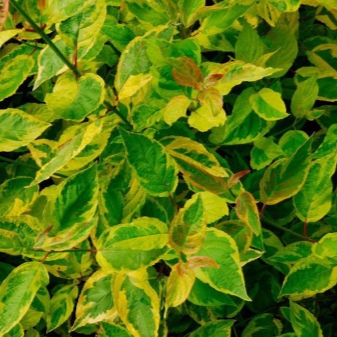
"Kesselringa" (Kesselringii)
A variety with unusual purple-black branches. The rounded crown goes up 2 - 2.5 m. White-pink small inflorescences blooming in autumn. The berries are round. Young foliage of bright green color turns purple in autumn.Svidina likes light, moist, acidic or neutral soil. Unpretentious, but pruning is required in March to give the desired shape.
In winter, with no foliage, it looks beautiful next to shrubs with yellow and red branches and shoots. Good in group planting or as a tapeworm.
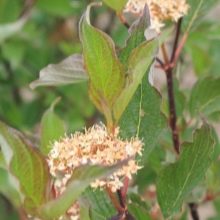

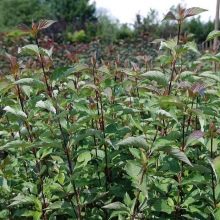
"Siberian Pearls" (Cornusalba Siberian Pearls)
Bright red branches, forming a spreading dense crown 2 - 2.5 m high. Oval, dark green above and bluish-whitish below, leaf plates look slightly wrinkled. By autumn, they acquire red-purple hues. Small fragrant flowers appear abundantly in the first decade of June. By autumn, drupe fruits turn from white into bluish-pinkish loose berries. Grows quickly, much better on moist, drained soils. It also easily tolerates lack of water and low temperatures.
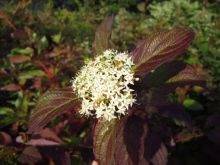
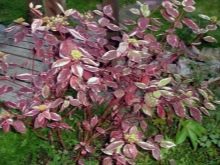
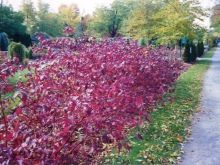
Sibirica
White deciduous telikrania 3 meters high with straight branches of coral-red color. Leaf plates of dark green tones become dark purple or burgundy closer to leaf fall. All summer, the bush dresses up in moon-shaped inflorescences. Whitish small drupe balls become bluish to ripeness. Siberica is one of the most popular dogwoods, as it survives in Siberian frosts, with a short summer and a short sunny day.
Loves rains, reacting to them by increasing the brightness of the leaves. With drought, the foliage turns pale and crumbles.
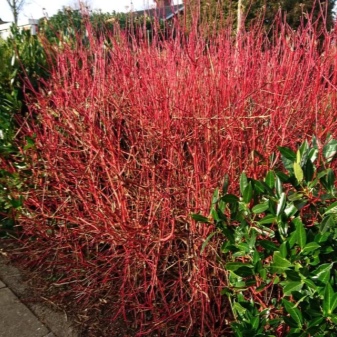
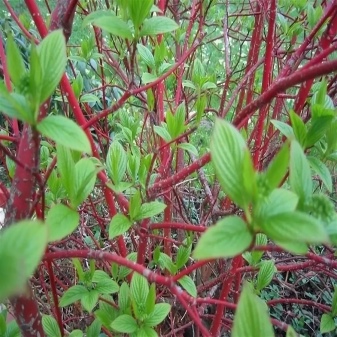
"Sibirica Variegata"
Also, svidina is not evergreen with mottled green leaf plates edged in pink. In winter, low (up to 1.5 m) dense purple-crimson shoots without foliage are seen. Variegated (variegated) leaves in white-green color. In the fall, the border remains pale, and the green changes to purple. Thus, telikrania pleases with its appearance and bright colors all year round. The flowers, as expected, are white, but with light greenery and a pleasant scent. White berries gradually ripen and turn bluish.
The shrub looks good with conifers and is suitable for hedges and landscaping. Unpretentious care.
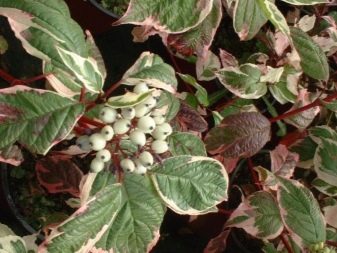
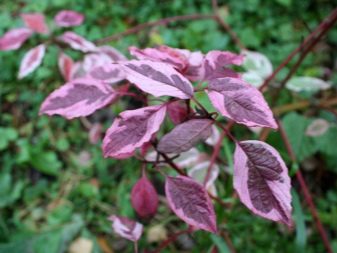
"Shpet" (Spaethii)
A large ornamental variety that grows up to 2 m high. In the spring, green leaf plates with a wide yellow border appear, in the fall the color changes to purple with yellow. Growth with reddish-brown bark and bluish berries by autumn. Small white flowers, large inflorescences located in the foliage, bloom from May to August.
It is frost-resistant enough, but under the condition of a snowy winter, otherwise the branches freeze slightly. Perfectly fulfills the role of a solitary plant in a garden or park, but also looks good in a group.
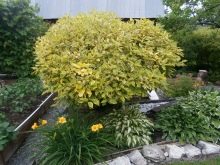
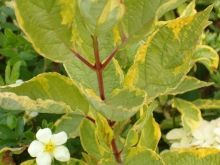
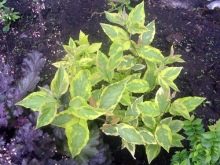
Breeding features
Svidina can be propagated in several ways: cuttings, root layers, seeds. When cultivated by cuttings, the planting material is cut in May-June and immediately planted in a school (this is the name of a temporary planting site for plant rooting). For this, grooves are dug 20 cm deep, which are covered with a mixture of peat and sand. The stalk is laid in such a way that it is pressed against the side of the groove. Pay attention that the buds are pointing up. The cuttings are manually covered with earth at a distance of 15 cm from each other.
Some gardeners water the seedlings after planting, but it is much easier to shed the soil first and then plant the cut branches. A sign that the cuttings have begun to give roots is the appearance of buds and the growth of shoots. In the fall, seedlings can be transplanted to a permanent place. The distance is chosen depending on the variety and purpose of planting: for a hedge, the distance is minimal, for decoration and landscaping - from 1.5 to 3-5 m.
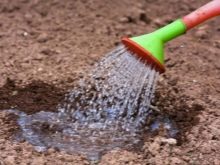
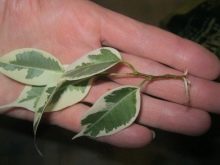
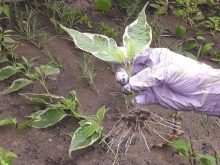
Since the dogwood is a spreading shrub, the lower branches often, nestling on the ground, give roots. Such twigs are carefully dug in so as not to damage the roots, the branch is chopped off from the center of the bush, the cuttings are transplanted to a permanent place.Often, to speed up this process, the side branches are specially dug in with earth in order to get root layers faster. Branches for transplanting in the winter must be chosen woody, otherwise there is a high probability of freezing of the layer.
The seed method is the most laborious and time consuming. When propagating by seeds, there are also several ways. In golden autumn, when the temperature does not exceed +5 degrees, the seeds are planted in a greenhouse, covered with peat, sand, sawdust, humus. The seeding density is 8-15 g / m2, the planting depth is 5 cm. Germination occurs in the second year, the transplant is carried out at a plant height of 50 cm. And if this is not an industrial production, then it is irrational to occupy a place in a greenhouse.
In southern latitudes, you can think about warming seeds in the open field, and in the middle lane and northern latitudes, you can try to grow a plant to permanent planting at home on a windowsill.
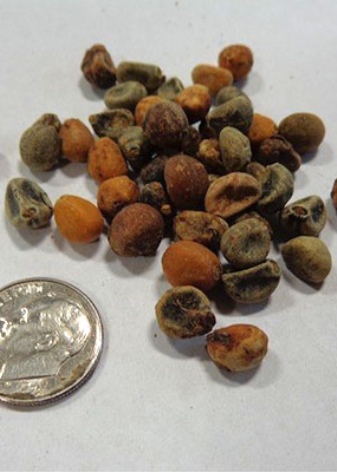
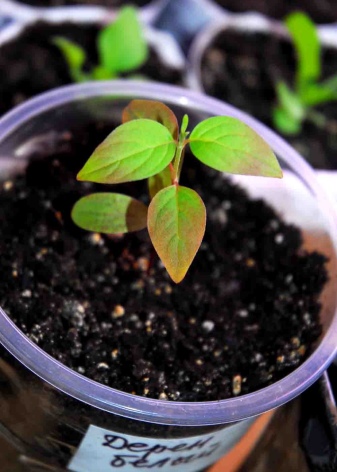
Landing rules
To plant shrubs of any of the listed varieties, no special skills are required. The unpretentiousness of the deren allows you to plant plants in almost any soil. Of course, mulched, drained soil will help it take root and grow faster, creating a lush, vibrant crown. And such a shrub will grow longer. But in some cases, seedlings are specially planted in former household waste dumps in order to hide the consequences of human activities.
Acidic soils and stagnant water impair the survival rate of turf. Although in some cases shrubs are planted in flooded areas, but since this is a temporary phenomenon associated with seasonal flooding, the plants can survive it. Loose soil is a way to supply oxygen to the root system and allow it to take root faster.
The more sun on the site, the brighter the foliage will be and the more interesting the color of the shoots in winter, especially for the varieties Elegantissima, Sibirica Variegata, Spaethii. But the shadow is also quite suitable for the svidina.
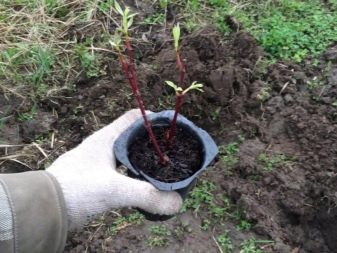
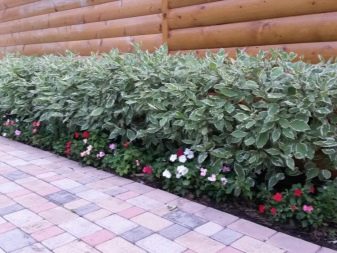
By timing, planting can be early spring or autumn. In early spring, when the ground has just begun to thaw and is full of moisture, the bush is planted in a permanent place. Some gardeners recommend choosing four-year-old seedlings. A shrub grown in a pot has a closed root system. Such a specimen can be planted in the fall, about a month before the onset of frost.
The roots are in a stable state, protected by soil from the container, and more easily adapt to a permanent place on the site. But the hole should still be much larger than the root system, because at the time of preparing the site for planting, the earth is dug up and saturated with oxygen. The result is that it is easier for roots to grow and take root in loosened soil. The earth must be well spilled with water. Usually, when planting a seedling, it takes at least a bucket of water.

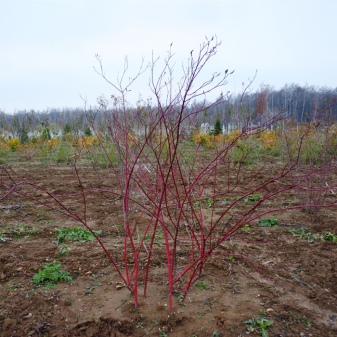
After the seedling is lowered into the hole and covered with earth, the soil is slightly trampled. When planting in spring, during the entire warm period, the seedlings should be watered about once a week. In dry times, more often. Adult plants are recommended to be watered once a decade, but this is also very conditional: it all depends on the weather. Different varieties of deren grow from 25 to 50 years.
What not to do when planting is fertilize with fresh "live" manure. From such a fertilizer, the bush can burn out, that is, die. Also, when planting, you should not strive to plant the tree too deep.
In plants, the place of transition from roots to tops is called the "root collar" and is determined by a change in color at this place. When planting, do not deepen the root collar.
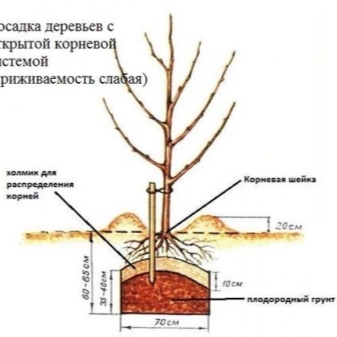

Subtleties of care
Caring for an ornamental shrub consists in watering, loosening, feeding, pruning, forming a bush. Watering the plant is required according to the weather, with the exception of newly planted seedlings. You can determine that the plant is sorely lacking moisture by looking at the leaves: they become soft, faded, gradually the branches become drooping.Watering is carried out in the morning or evening, otherwise the water will quickly evaporate on a hot afternoon, and the earth will crack and turn into stone. Loosening is carried out not only to remove weeds, but also to supply oxygen, this is the so-called "dry irrigation". Loosening of adult plants is carried out in autumn and spring to the width of the crown. Young bushes need to be torn off (dug up) with care so as not to damage the roots.
Almost all plants love nitrogen fertilizers, and derain is no exception. These can be purchased at gardening and gardening stores. In summer, peat or natural fertilizers from a compost heap are suitable as fertilizers. But feeding is carried out if the land is very poor. And in general, svidina is quite unpretentious, including for feeding - only diseased plants and young growth need humus more often than others.
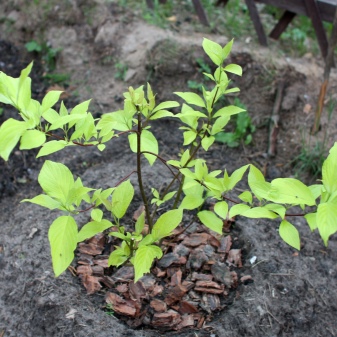
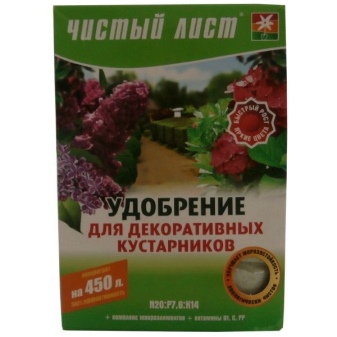
Pruning is required for ornamental plants, especially those used in landscaping. The purpose of pruning is to form a crown and slow the growth of the shrub. Sanitary pruning is carried out 2-3 times per season. If it is not carried out, then the old branches below become bare, gradually dry out. The shoots, after pruning, grow quickly and turn the bush into a lush plant.
For work, you should prepare work gloves, a hacksaw, a garden pruner, an ax. First, branches with fungal spots, dry or frostbitten, as well as crookedly growing branches are removed. Sanitary pruning begins in the third year after planting. Pruning time is spring and autumn: to stimulate abundant flowering and dense foliage, branches are pruned in the fall; to admire the bright multi-colored shoots, pruning is left until spring.
During the season, the shoots are pruned 2-3 times by 1/3 - 1⁄4 of the branch.
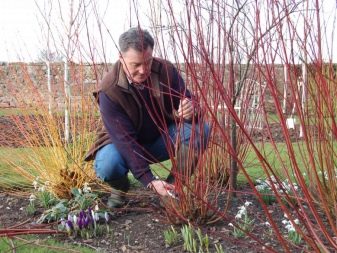
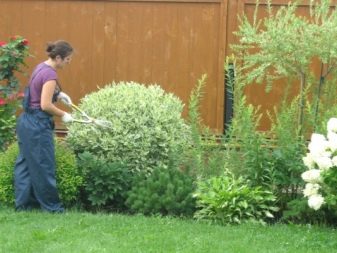
The shrub is pruned in several forms:
- in the form of a hemisphere, they choose low, spreading bushes for this;
- arched, arched, since the branches of the deren are very flexible, they are attached to the frame or fence;
- in the form of a candle, stele, column; varieties that grow upward, and not to the sides, are suitable for this, the tops are cut off in the form of a candle flame, a pointed stele or a cylindrical column;
- in the form of animals or geometric shapes, while you can use not only the shrub itself, but also the frame structure to shape it.
Derain does not need shelter during the winter.
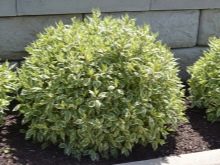
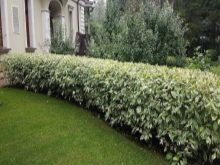
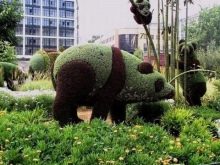
Diseases and pests
Like many fruit shrubs, white turf can suffer from gray mold and powdery mildew, as well as from insects: aphids and scale insects. The cause of fungal diseases is often not only excessive watering, but also self-spraying of spores. Most likely, a sick tree or shrub is growing somewhere nearby. Sick branches must be removed and thrown as far as possible from the site, and the bush must be treated with Bordeaux mixture, topsin, chorus or other fungicides. Aphids and thyroid gland are sprayed with pest remedies - from steamed potato tops, tobacco, mustard, to karbofos and aktara.
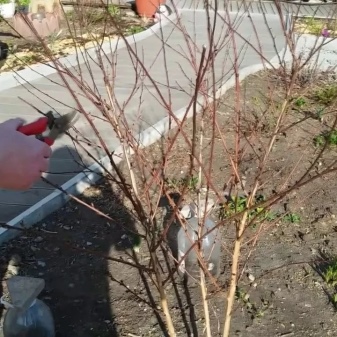
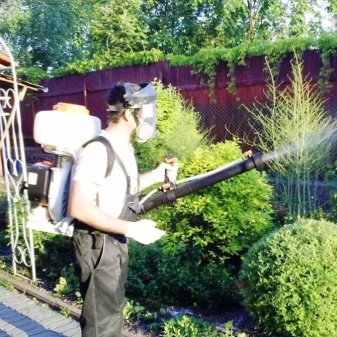
Examples in landscape design
Derain can be a single decoration - a tapeworm on a site or in a park. For example, this is the white-bordered Elegantissima.
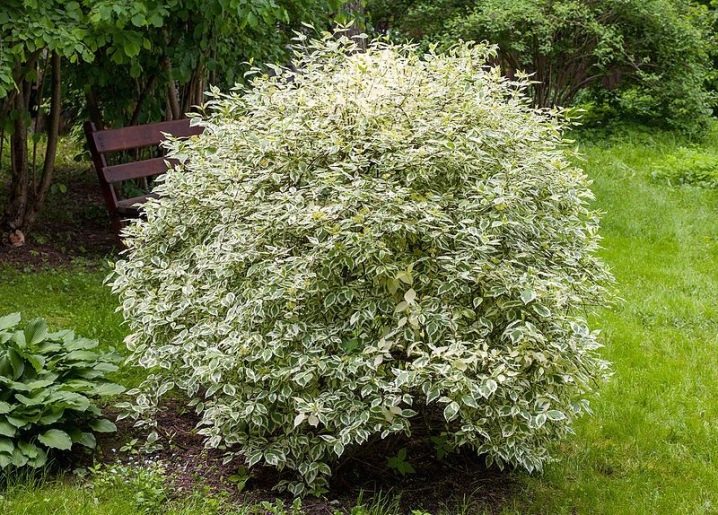
But he also looks great in a group. Therefore, this shrub is used as a universal means for the improvement of parks and personal plots. Tall deren bushes, planted along the fence, perfectly set off flower arrangements and creeping plants.
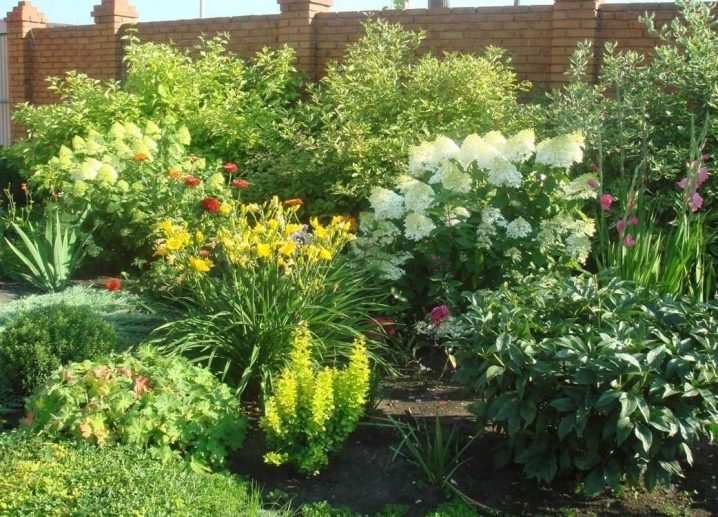
Derain white is suitable for creating a mixborder in combination with coniferous shrubs, ivy, alissum, fern, spirea.
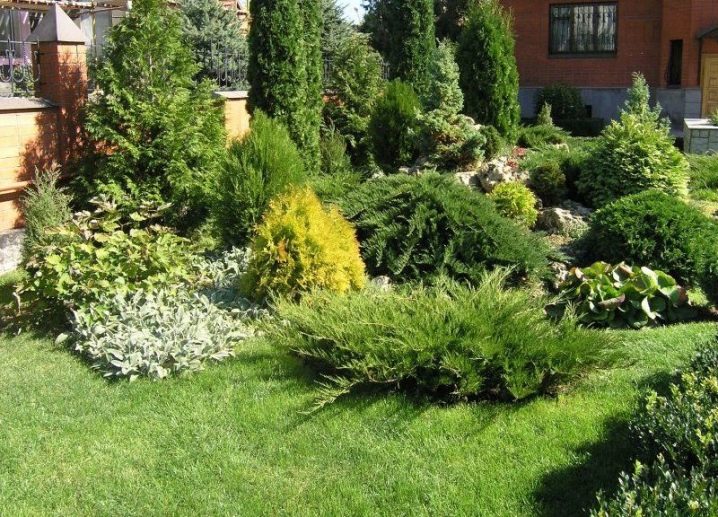
Shpeta will decorate the flower bed in the earliest spring and late autumn, when the rest of the tall plants have no foliage.

Different varieties of svidina, planted nearby, will not only make the site bright throughout the year, but also help create an atmosphere of comfort, relax your soul next to a beautiful plant.
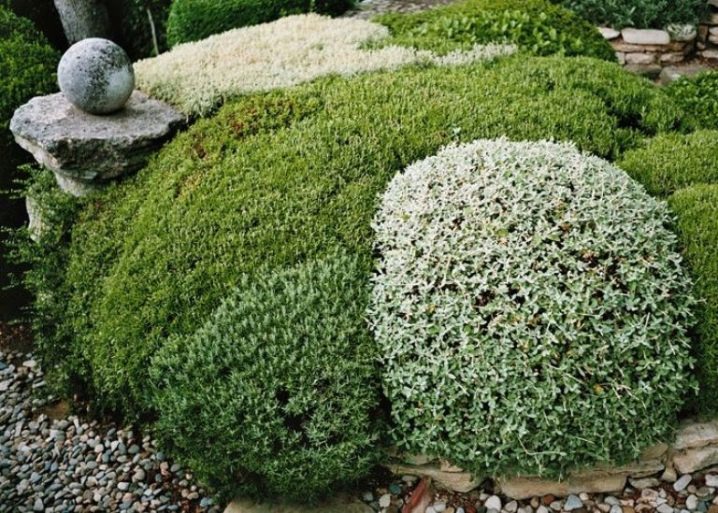
There is even more information about white dogwood in the video below.

































































The comment was sent successfully.